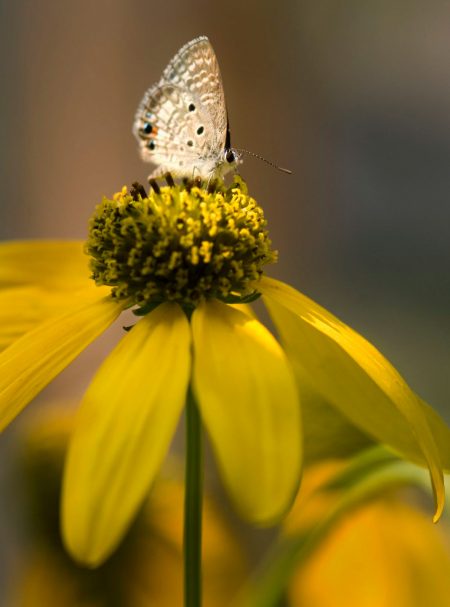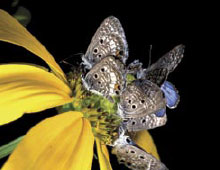Drawn by turquoise waters and sun-drenched white sand beaches, hoards of tourists annually flock to Bahia Honda State Park, a small 524-acre island in the Lower Florida Keys. Nowadays, though, many visitors have shed the snorkel gear. Armed instead with cameras or binoculars, they trek less traveled paths in hopes of getting a glimpse of the park’s rarest inhabitant-the endangered Miami Blue butterfly.

Florida Museum photo by Jeff Gage
The excitement surrounding this tiny insect with the prominent, homegrown name has attracted nature lovers from across the nation. It also has rallied politicians, governmental agencies, conservation organizations and biologists throughout Florida to unite for the common goal of saving a species, and in the process, focused new attention on the importance of invertebrate conservation.
The Miami Blue, Cyclargus thomasi bethunebakeri, once ranged from the South Florida mainland south through the Keys to the Dry Tortugas. A widely encountered inhabitant of tropical hardwood hammocks, beachside scrub and tropical pinelands, it flew in close proximity to its weedy, somewhat rambling larval host plants, balloon vine and nickerbean.
Over the last few decades, though, the butterfly’s population numbers began to spiral downward. Reliable haunts on the South Florida mainland rapidly succumbed to expanding urbanization. In recent years, this alarming trend of decline continued in the Florida Keys. Following the devastation wrought by Hurricane Andrew in 1992, known populations were isolated and scarce. Even the historical stronghold locations of Key Largo and Big Pine Key failed to register verified sightings. Fueled by such dim prospects, fear grew that the butterfly may have sadly gone extinct. A reprieve came on Nov. 19, 1999, when a small relict population was discovered within the boundaries of Bahia Honda State Park.
Prompted by this finding, the North American Butterfly Association filed petitions with the U.S. Fish and Wildlife Service and the Florida Fish and Wildlife Conservation Commission to emergency- list the butterfly as endangered. Owing to the Miami Blue’s recent decline and extremely tenuous current situation, the Florida Fish and Wildlife Conservation Commission soon added the butterfly to Florida’s endangered species list, granting it additional protection under the law. While unable to follow suit, the U.S. Fish and Wildlife Service funded a one-year status survey and ecological study.
I and several other researchers confirmed that the single remaining population was actually a metapopulation consisting of more than a dozen separate, but loosely connected breeding colonies, and estimated that the park supported less than seventy-five individuals at any one time. This startlingly low number catapulted the Miami Blue into an unenviable category as one of the nation’s most critically imperiled invertebrates.

Photo by Jaret C. Daniels
As it was clear that an aggressive conservation effort was needed, state and federal agencies jointly agreed to establish a captive propagation program for the butterfly. Starting in Feb. 2003, McGuire Center researchers collected 100 eggs from the Bahia Honda State Park metapopulation to initiate a captive colony in University of Florida breeding laboratories. Intended ultimately to generate the numbers needed for future field reintroductions, the captive colony helped address many needs, from conserving a representative sample of the remaining genetic diversity available to immediately alleviating the potential threat of species extinction resulting from a natural or manmade disaster striking Bahia Honda.
Although a considerable challenge, the breeding program has been far more successful than initially imagined. Now more than a year old and with some 13 generations complete, the captive colony has produced more than 9,000 individuals. The next step, scheduled to begin in May 2004, will involve large-scale wild reintroductions into the federally protected lands of Biscayne and Everglades National parks in hopes of establishing new breeding populations. Taken together, the collaborative program represents one of the largest conservation efforts ever undertaken for a butterfly. And, if ultimately successful, it will direct the Miami Blue down the road to recovery.
Jaret C. Daniels, Ph.D., is an insect ecologist at the McGuire Center for Lepidoptera and Environmental Research at the Florida Museum of Natural History.